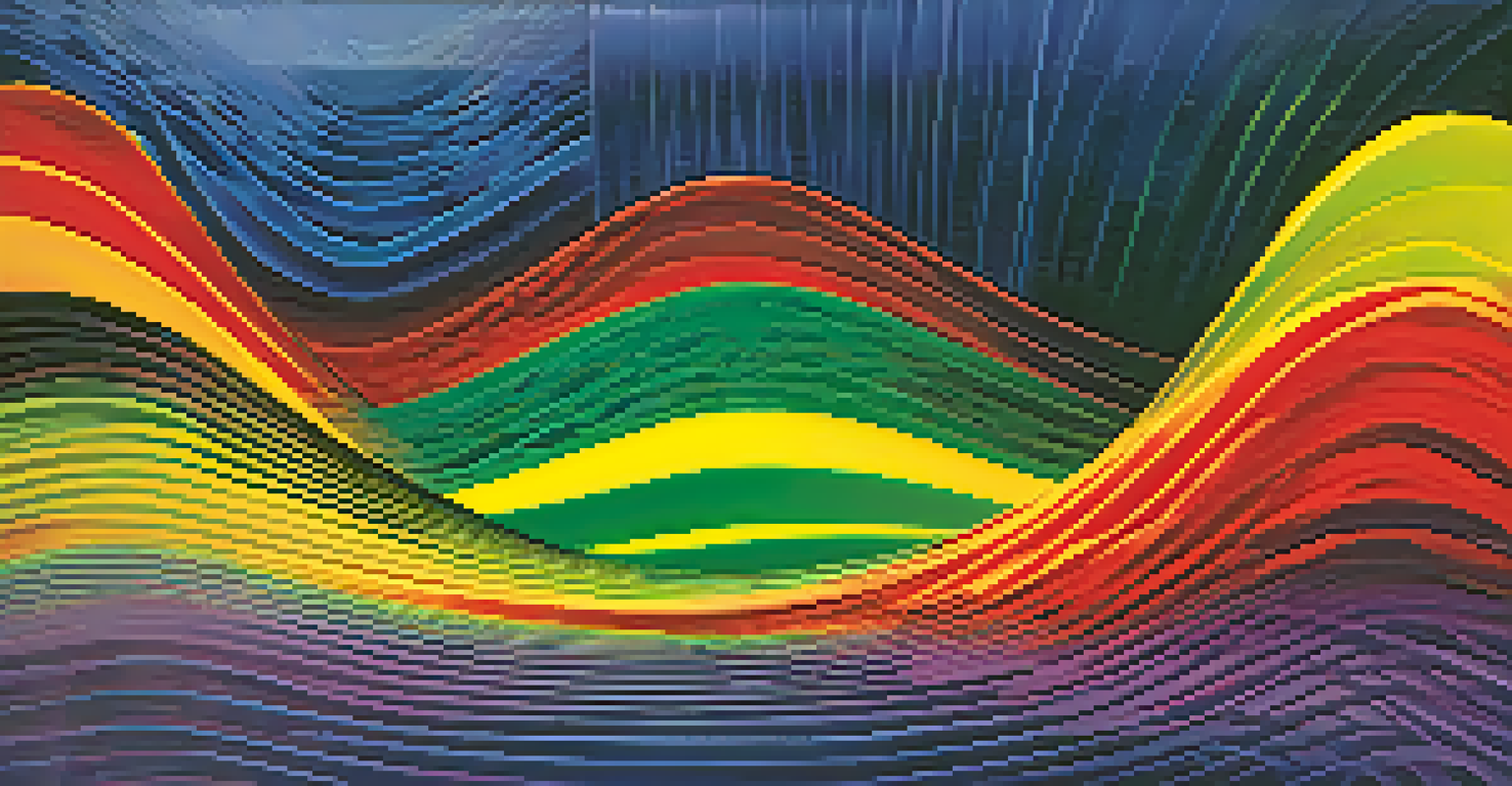The Nature of Sound: Understanding Wave Properties and Behavior

What is Sound and How Does It Travel?
Sound is a form of energy that travels through a medium, such as air, water, or solids. When an object vibrates, it creates pressure waves that move through these media. This is why we can hear sounds from various sources, like music or conversations, even when we’re not directly next to them.
Sound is the vocabulary of nature.
Imagine throwing a pebble into a calm pond; the ripples that spread out are similar to how sound waves propagate. As these waves travel, they can vary in speed depending on the medium. For instance, sound travels faster in water than in air due to the closer arrangement of molecules.
Understanding how sound travels helps us appreciate its role in communication, music, and even the natural world. Whether it’s the chirping of birds or the roar of thunder, sound is a vital part of our environment.
The Science Behind Sound Waves
Sound waves are primarily classified into two types: longitudinal and transverse. Longitudinal waves, like those created by a vibrating string or a speaker cone, move the medium's particles back and forth in the same direction as the wave. In contrast, transverse waves, such as those seen in water, move particles up and down perpendicular to the direction of travel.

These wave types reveal fascinating properties of sound, such as frequency and amplitude. Frequency refers to the pitch of the sound, measured in hertz (Hz), while amplitude relates to the loudness. Higher frequencies produce higher pitches, while greater amplitudes create louder sounds.
Sound Travels Through Mediums
Sound is energy that moves through air, water, or solids via pressure waves created by vibrating objects.
By grasping these concepts, we can better understand everything from musical notes to the sounds of nature. For example, a dog’s bark has a different frequency compared to a piano note, showcasing the diversity of sound we encounter daily.
Frequency: The Key to Pitch and Sound Quality
Frequency plays a crucial role in determining how we perceive sound. It’s the rate at which sound waves vibrate, influencing the pitch we hear. A higher frequency corresponds to a higher pitch, while a lower frequency means a deeper tone, like that of a bass guitar.
The ear is the avenue to the heart.
Think of frequency as a musical scale; each note corresponds to a specific frequency. When musicians tune their instruments, they adjust the frequencies to achieve harmony. This tuning process is essential for creating music that resonates with listeners.
Understanding frequency also enhances our appreciation of sound in everyday life. From the soothing chirps of crickets at night to the sharp crack of a whip, frequency shapes our auditory experiences.
Amplitude: Loudness and Sound Intensity Explained
Amplitude is a measure of the energy of a sound wave, directly correlating with how loud the sound is. A wave with a larger amplitude will produce a louder sound, while a smaller amplitude results in a softer sound. This concept is crucial in various applications, from music production to public speaking.
Imagine standing close to a speaker at a concert; the loud music you hear is a result of high amplitude sound waves. Conversely, if you step away, the sound diminishes in intensity due to lower amplitude as the waves disperse over distance.
Frequency Defines Pitch and Quality
The frequency of sound waves influences how we perceive pitch, with higher frequencies producing higher notes.
By understanding amplitude, we can manipulate sound for desired effects, whether we want to amplify our voice for a presentation or create a quiet ambiance for relaxation. It’s all about controlling how we experience sound in different contexts.
The Role of Wavelength in Sound Propagation
Wavelength is the distance between consecutive peaks of a sound wave and is inversely related to frequency. This means that as the frequency increases, the wavelength decreases. Wavelength impacts how sound interacts with its environment, affecting everything from music acoustics to how we hear distant sounds.
Consider the difference in how high-pitched sounds and low-pitched sounds behave in a room. High-pitched sounds have shorter wavelengths, allowing them to reflect off surfaces and create echoes, while low-pitched sounds travel longer distances and can pass through obstacles more easily.
Understanding wavelength enhances our awareness of sound behavior in various settings. This knowledge is particularly useful in designing concert halls or recording studios, where sound quality is paramount.
Reflection, Refraction, and Diffraction of Sound Waves
Sound waves can behave like light waves, exhibiting phenomena like reflection, refraction, and diffraction. Reflection occurs when sound bounces off a surface, akin to how an echo is created when you shout in a canyon. This property is why we hear sounds differently in various environments.
Refraction involves the bending of sound waves when they pass through different media, such as from air into water. This bending can affect how we perceive sounds under water versus above water, often leading to distorted or altered sounds.
Amplitude Affects Loudness
The amplitude of sound waves determines their loudness, where larger amplitudes result in louder sounds.
Diffraction allows sound waves to bend around obstacles and spread out in the open, making it possible to hear someone calling you from around a corner. Understanding these behaviors helps us navigate our auditory world, from enjoying music to recognizing sounds in nature.
The Impact of Temperature and Medium on Sound
The speed of sound is influenced by the medium through which it travels and the temperature of that medium. For example, sound travels faster in warm air than in cold air because warmer molecules vibrate more quickly, allowing sound waves to move more efficiently.
This phenomenon can be observed in everyday life. Have you ever noticed how sounds seem to carry better on a warm summer evening compared to a chilly winter night? The temperature affects how sound waves propagate, significantly impacting our listening experience.

By grasping the relationship between temperature, medium, and sound, we can better understand natural phenomena and even improve technologies such as sonar and audio equipment. It’s a world of sound that is continuously influenced by the environment around us.